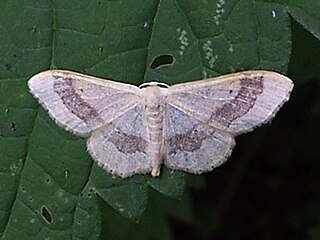
Idaea, sometimes called Hyriogona, is a large genus of geometer moths. It was erected by Georg Friedrich Treitschke in 1825. They are found nearly worldwide, with many native to the Mediterranean, the African savannas, and the deserts of western Asia.

Parotis is a genus of moths of the family Crambidae.

Chaetolopha is a genus of moths in the family Geometridae. Most species are endemic to Australia. A number of species previously assigned to this genus, were reassigned to the new genus Parachaetolopha in 2002.

Didymoctenia is a monotypic moth genus in the family Geometridae and subfamily Ennominae which was described by Warren in 1901. Its only species, Didymoctenia exsuperata, the thick-lined bark moth, was first described by Francis Walker in 1860. It is found in Australia.

Symmacra is a monotypic moth genus in the family Geometridae described by Warren in 1896. Its only species, Symmacra solidaria, was first described by Achille Guenée in 1858. It is found in Indo-Australian tropics of India, Sri Lanka, Borneo east to Fiji, Samoa and Australia.

Parotis suralis is a moth of the family Crambidae. The species was first described by Julius Lederer in 1863. It is found around the west Pacific Rim, including the Chagos Islands, Hong Kong, Japan, Kiribati, Tuvalu and the tropical far north of Queensland.
Theila siennata is a moth in the family Crambidae. It was described by Warren in 1896. It is found in Australia, where it has been recorded from Queensland. The species has been suggested as a biological control agent in the United States.
Conogethes diminutiva is a moth in the family Crambidae. It was described by William Warren in 1896. It is found in India and Australia.
Parotis punctiferalis is a moth in the family Crambidae. It was described by Francis Walker in 1866. It is found in New Guinea, Australia and China.
Parotis marinata is a moth in the family Crambidae. It was described by Johan Christian Fabricius in 1784. It is found in India, Sri Lanka, New Guinea, on the Solomon Islands, the Democratic Republic of the Congo, South Africa. and Australia.
Parotis pomonalis is a moth in the family Crambidae. It was described by Achille Guenée in 1854. It is found in China, India, Sri Lanka, Borneo, Sumbawa and Australia.
Prophantis triplagalis is a moth in the family Crambidae. It was described by William Warren in 1896. It is found in India, where it has been recorded from the Khasia Hills.
Pycnarmon radiata is a moth in the family Crambidae. It was described by William Warren in 1896. It is found in China and India.
Rhectothyris rosea is a moth in the family Crambidae. It was described by William Warren in 1896. It is found in Assam, India and Australia, where it has been recorded from Queensland.
Syllepte nigriscriptalis is a moth in the family Crambidae. It was described by William Warren in 1896. It is found in India, where it has been recorded from Assam and Australia, where it has been recorded from Queensland.

Phazaca interrupta is a species of moth of the family Uraniidae first described by William Warren in 1896. It is found in Australia, where it has been recorded from Western Australia, Queensland and New South Wales.

Oreta jaspidea is a moth in the family Drepanidae. It was described by William Warren in 1896. It is found on Buru, the Key Islands, New Guinea, the Bismarck Archipelago, the Louisiade Archipelago, Australia (Queensland) and the Solomon Islands.
Petrophile incurvata is a species of flowering plant in the family Proteaceae and is endemic to southwestern Western Australia. It is a shrub with flattened, sometimes pinnately-divided leaves with up to five sharply pointed lobes, and cylindrical to oval heads of silky-hairy, cream-coloured to yellowish-white flowers.

Margaroniini is a tribe of the species-rich subfamily Spilomelinae in the pyraloid moth family Crambidae. The tribe was erected by Charles Swinhoe and Everard Charles Cotes in 1889.








